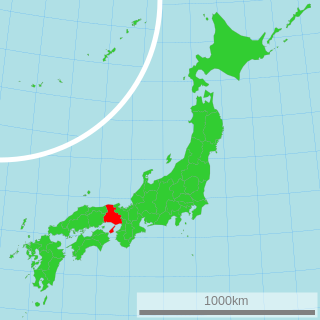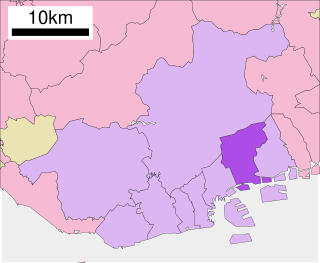
The Kansai region or the Kinki region lies in the southern-central region of Japan's main island Honshū. The region includes the prefectures of Mie, Nara, Wakayama, Kyoto, Osaka, Hyōgo and Shiga, sometimes Fukui, Tokushima and Tottori. While the use of the terms "Kansai" and "Kinki" have changed over history, in most modern contexts the use of the two terms is interchangeable. The urban region of Osaka, Kobe, and Kyoto is the second-most populated in Japan after the Greater Tokyo Area.

Nishinomiya is a city located in Hyōgo Prefecture, Japan, between the cities of Amagasaki and Ashiya. On April 1, 2005, the city of Nishinomiya celebrated its 80th anniversary. It is best known as the home of Kōshien Stadium, where the Hanshin Tigers baseball team plays home games and where Japan's annual high school baseball championship is held. It is also the location of Kwansei Gakuin University, a private university founded by American missionaries in the nineteenth century. Nishinomiya is an important commercial and shipping city in the Kansai region with the third largest population in Hyōgo Prefecture.
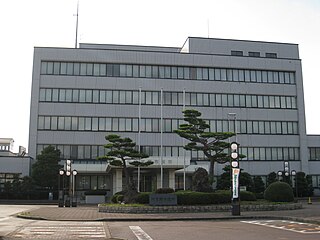
Agano is a city located in Niigata Prefecture, Japan. As of 1 June 2016, the city had an estimated population of 42,651 in 14,417 households, and a population density of 223 persons per km². ItsThe total area of the city was 192.74 square kilometres (74.42 sq mi).

Rokkō Island is a man-made island in Higashinada-ku, Kobe, Japan. It is located in the southeast region at Port of Kobe. The island has a 3.4 km by 2 km rectangular shape, and covers 5.80 km² or 1,400 acres. The residential area of the island, featuring apartment buildings -- many with views of the sea -- and single family homes, is located in the center of the island. A green belt separates the residential area from industrial and port activities. The two international schools located on the island attract many foreign residents to the island.

Hanshin Department Store is a Japanese department store chain owned by Hankyu Hanshin Department Stores, Incorporated, a subsidiary of H2O Retailing Corporation.

Konan University is a university on the slopes of Mount Rokkō in Higashinada-ku, Kobe, Japan. A private university with approximately 10,000 students, it offers a wide variety of programs to Japanese students, as well as an international exchange program through the Konan International Exchange Centre.
Hanshin, derived from the second kanji from Ōsaka (大阪) and the first kanji from Kōbe (神戸), refers generally to the area between Osaka and Kobe in the Kansai region of Japan.
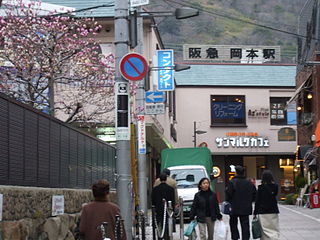
Okamoto Station is a railway station on the Hankyu Kobe Line in Higashinada-ku, Kobe, Hyōgo Prefecture, Japan, between Mikage Station and Ashiyagawa Station.
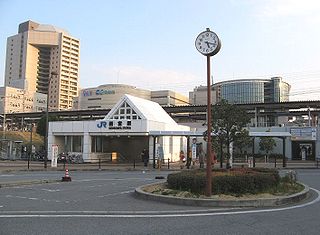
Nishinomiya Station is a railway station located in Ikeda-chō (池田町), Nishinomiya, Hyōgo, Japan operated by the West Japan Railway Company. The station is on the JR Kobe Line which runs between Osaka Station and Himeji Station; part of the main Tōkaidō Line. As a part of the JR West Urban Network, the following cards are accepted: J-Thru Card, ICOCA, Suica, Pasmo, and PiTaPa.
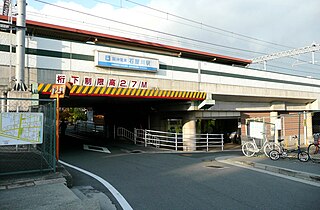
Ishiyagawa Station is a railway station in Higashinada-ku, Kobe, Hyōgo Prefecture, Japan.

Shinzaike Station is a railway station in Nada-ku, Kobe, Hyōgo Prefecture, Japan.

Sawanotsuru Co. Ltd (沢の鶴株式会社) is one of Japan’s largest producers of sake. The company was founded in 1717 in Nada-ku, Kobe, a region famous for sake production. According to Sawanotsuru Co., its sake is exported to approximately 30 countries.

Hanshinkan Modernism (阪神間モダニズム) identifies the modernist arts, culture, and lifestyle that developed from the region of Japan centered primarily on Hanshinkan, the ideally terrained area between the Rokkō Range and the sea from the 1900s through the 1930s, or the circumstances of that period.

DSK International is an international school on Rokkō Island, in Higashinada-ku, Kobe, Japan. DSK International is an International IB school in Kobe. Our school provides a unique and multilingual education to learners ages 2 to 12. To meet the unique needs of our learners, our school provides curriculum in three languages: German, English and Japanese in our two branches. DSK International offers three programmes for learners ages 2-12: Playgroup, Early Years and Primary Years Programme (PYP).
Lutheran International Schools (ルーテル国際学園ノルウェー学校) was a Norwegian international school in Kobe, Japan. It was previously in Tarumi-ku, and it later was located on Rokko Island in Higashinada-ku. The school served grades 1-9. It accepted Danish and Swedish students in addition to Norwegian ones.



